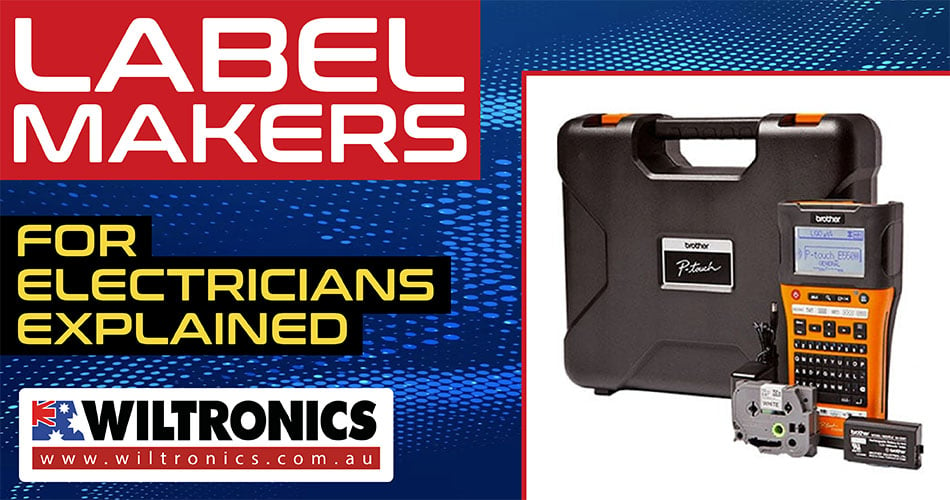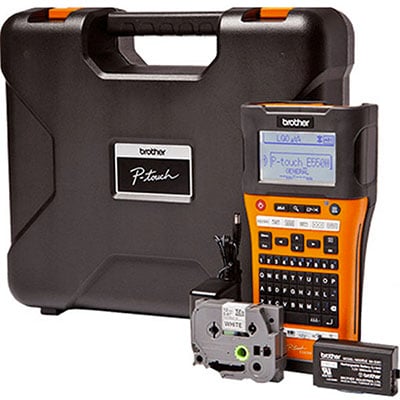Label Makers for Electricians Explained
July 25, 2023

In the fast-paced world of electrical work, precision and organisation are essential. Electricians rely on attention to detail to ensure seamless operations and safe maintenance. This is where label makers come into play.
In this guide, we will explore the crucial role of labelling in the electrical industry. Plus, learn some effective techniques!
The Role of Label Makers in Electrical Work
Labelling is a fundamental aspect of electrical work, ensuring the following:
- safety
- efficiency
- streamlined maintenance
First, labelling promotes increased safety in electrical installations. Properly labelled wires, cables, and components allow for quick identification. Most importantly, it enables electricians to distinguish between different circuits. This is particularly crucial during troubleshooting or emergency situations.
Organised and well-labelled electrical installations also enhance overall efficiency. Electricians can easily locate and identify specific components. This saves valuable time and minimises the risk of errors during repairs. Clear labels also help provide effective communication between electricians, reducing misunderstandings on complex projects.
Furthermore, maintenance becomes easier and more streamlined with detailed labelling. Clear and legible labels enable efficient documentation of wiring systems. This makes it simpler to trace and identify faults, including:
- perform routine inspections
- carry out necessary repairs
This ultimately leads to cost savings and increased uptime for electrical systems. To help you achieve these benefits, the Brother P-Touch Labeller is an ideal solution!

Exploring the Brother P-Touch Labeller
The Brother P-Touch Labeller is a versatile and feature-rich label maker. This model is specifically designed to meet the unique requirements of electricians. It stands out from the rest with its comprehensive functionality and user-friendly interface.
Key features include:
- The label maker produces durable, laminated labels. Not just ordinary labels, though, but professional-quality ones. Meaning they are resistant to water, oil, and harsh environmental conditions. This ensures longevity and legibility.
- With the built-in WiFi, you can connect your mobile device or PC to the label maker. This enables seamless label creation and editing.
- The device boasts a large, easy-to-read display with backlighting. This allows for creating and previewing labels even in low-light environments.
- Offers a wide range of design options. These include pre-designed templates and creating custom labels.
- The built-in automatic cutter enables quick and precise label cutting. This saves time and improves efficiency.
Additional accessories included with the product may vary. But typically, the Brother P-Touch Labeller comes with the following:
- Rechargeable battery pack
- AC adapter
- Durable carrying case
- USB cable
- Label tape
Overall, it empowers electricians to create professional-grade labels efficiently. Its exceptional features make it an invaluable tool in electrical installations.
Essential Labels for Electrical Installations
Some common label types and their purposes include:
Wire and cable labels
These labels are used to identify individual wires or cables within a system. They typically display information such as wire gauge, voltage rating, and function. Wire labels help electricians trace and troubleshoot circuits efficiently.
Panel and equipment labels
These labels are applied to electrical panels, distribution boards, switches, and other equipment. They provide essential information such as circuit designations, warnings, and safety instructions. This ensures clear identification of specific components. Plus, it helps prevent accidental disconnections or improper usage.
Safety labels
May include symbols, texts, or colour codes to emphasise safety precautions and warnings. Safety labels promote awareness and compliance with safety regulations. Thus, minimising the risk of accidents or electrical hazards.
Tips for Using Label Makers Effectively
To make the most of your labeller, follow these guidelines:
1. Familiarise yourself with the user manual
Read the user manual to understand the device’s features, settings, and functionality. This knowledge will enable you to maximise the capabilities of the label maker.
2. Utilise pre-designed templates
If your labeller comes with pre-designed templates, take advantage of them. Doing so will enable you to create professional-looking labels quickly. This can include wire markers, equipment labels, safety signs, and more.
3. Customise labels
Tailor labels to your specific needs by utilising customisable features. Experiment with different fonts, sizes, symbols, and barcodes.
4. Consider label placement
Place labels in visible and accessible locations to ensure easy identification. For wires and cables, affix labels near connection points. Or at intervals along their lengths for clear tracking and maintenance.
5. Opt for durable label tapes
Use high-quality, laminated label tapes compatible with your labeller for enhanced durability. These tapes are resistant to water, chemicals, and harsh conditions. They make sure the labels remain legible and intact over time.
6. Clean and prepare surfaces
Before applying labels, ensure the surfaces are clean and dry. Smooth surfaces allow labels to adhere properly and minimise the risk of peeling.
7. Maintain proper label maker care
Keep the label maker clean by regularly wiping it with a soft, lint-free cloth. Avoid using abrasive materials or solvents that may damage the device. When not in use, store the label maker in a safe and dry place.
FAQs
How do I choose the right label maker for my needs?
Consider factors such as label type compatibility, connectivity options, printing capabilities, and durability. Assess your specific requirements and compare different models to find the best fit.
Can I create custom labels with a label maker?
Yes, most label makers allow customisation. You can often select fonts, sizes, symbols and even add barcodes. Some models offer additional design features like templates and graphics.
How do I conserve label tape and reduce waste?
Plan and preview labels before printing to avoid unnecessary tape wastage. Utilise features like auto-sizing and label length settings to optimise tape usage.
What should I do if the label does not stick properly?
Ensure that the surface is clean and dry before applying the label. Press firmly and hold for a few seconds to ensure proper adhesion. Consider using specialised label tape for challenging surfaces.
How do I troubleshoot label printing issues?
Check that the label maker has enough battery or power. Verify that the label tape is properly installed and compatible with the device. Clean the print head if labels appear faded or distorted.
Can I print labels from my smartphone or computer?
Some label makers offer wireless connectivity. This allows you to print labels directly from mobile devices or computers. Check if your model supports this feature and follow the instructions for setup.
The Bottom Line
Label makers are indispensable tools for electricians. They offer a multitude of benefits in terms of safety, efficiency, and maintenance. Clear and organised labelling enhances safety by preventing errors and accidents. At the same time, promoting efficient troubleshooting and maintenance.
The Brother P-Touch Labeller stands out as a recommended solution with its advanced features. Investing in a reliable label marker like this can pave the way for successful projects and a safer working environment!
© Wiltronics Research Pty Ltd 2023
Write a Comment
You must be logged in to post a comment.